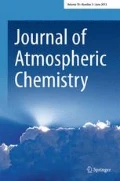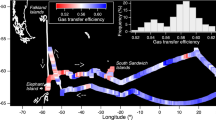Abstract
Gas exchange experiments were conducted in the tropical Atlantic Ocean during a ship expedition with FS Meteor using a small rubber raft. The temporal change of the mixing ratios of CO, H2, CH4 and N2O in the headspace of a floating glass box and the concentrations of these gases in the water phase were measured to determine their transfer velocities across the ocean-atmosphere interface. The ocean acted as a sink for these gases when the water was undersaturated with respect to the mixing ratio in the headspace. The transfer velocities were different for the individual gases and showed still large differences even when normalized for diffusivity. Applying the laminar film model, film thicknesses of 20 to 70 μm were calculated for the observed flux rates of the different gas species. When the water was supersaturated with respect to atmospheric CO, H2, CH4 and N2O, the transfer velocities of the emission process were smaller than those determined for the deposition process. In case of H2 and CH4, emission was even not calculable although, based on the observed gradient, the laminar film model predicted significant fluxes at the air-sea interface. The results are interpreted by destruction processes active within the surface microlayer.
Similar content being viewed by others
References
Broecker, W. S., and Peng, T. H., 1974, Gas exchange rates between air and sea, Tellus 26, 21–35.
Broecker, H. C., Petermann, J., and Siems, W., 1978, The influence of wind on CO2-exchange in a wind-wave tunnel, including the effects of monolayers, J. Mar. Res. 36, 595–610.
Conrad, R., and Seiler, W., 1982, Utilization of traces of carbon monoxide by aerobic oligotrophic microorganisms in ocean, lake and soil, Arch. Microbiol. 132, 41–46.
Conrad, R., Seiler, W., Bunse, G., and Giehl, H., 1982, Carbon monoxide in sea water (Atlantic Ocean), J. Geophys. Res. 87, 8839–8852.
Conrad, R., Seiler, W., and Bunse, G., 1983, Factors influencing the loss of fertilizer-nitrogen into the atmosphere as N2O, J. Geophys. Res. 88, 6709–6718.
Crozier, T. E., and Yamamoto, S., 1974, Solubility of hydrogen in water, sea water, and NaCl solutions, J. Chem. Engineer, Data, 19, 242–244.
Deacon, E. L., 1977, Gas transfer to and across an air-water interface, Tellus 29, 363–374.
De, Souza Lima, Y., 1985, Accumulation de sels nutritifs dans la microcouche de surface: influence possible des facteurs abiotiques et biotiques du milieu, Oceanologica Acta 8, 47–58.
Douglas, E., 1967, Carbon monoxide solubilities in sea water, J. Phys. Chem. 71, 1931–1933.
Hardy, J. T., and Apts, C. W., 1984, The sea-surface microlayer: phytoneuston productivity and effects of atmospheric particulate matter, Mar. Biol. 82, 293–300.
Hartman, B., and Hammond, D. E., 1984, Gas exchange rates across the sediment-water and air-water interfaces in South San-Francisco Bay, J. Geophys. Res. 89, 3593–3603.
Hermansson, M., and Dahlbäck, B., 1983, Bacterial activity at the air-water interface, Microb. Ecol. 9, 317–328.
Jähne, B., Münnich, K. O., and Siegenthaler, U., 1979, Measurements of gas exchange and momentum transfer in a circular wind-water tunnel, Tellus 31, 321–329.
Lion, L. W., 1984, The surface of the ocean, in The Handbook of Environmental Chemistry, vol. 1C, O., Hutzinger, (ed.), Springer, Berlin, pp. 79–194.
Lion, L. W., and Leekie, J. O., 1981, The biogeochemistry of the air-sea interface. Ann. Rev. Earth Planet. Sci. 9, 449–486.
Liss, P. S., 1975, Chemistry of the sea surface microlayer in Chemical Oceanography, vol. 2, J. P., Riley and G., Skirrow (eds.), 2nd edn., Academic Press, London, pp. 193–243.
Liss, P. S., and Merlivat, L., 1986, Air-sea gas exchange rates: field measurements, in The Role of Air-Sea Exchange in Geochemical Cycling, P., Buat-Ménard (ed.), D. Reidel, Dordrecht, pp. 113–127.
Liss, P. S., and Slater, P. G., 1974, Flux of gases across the air-sea interface, Nature 247, 181–184.
Merlivat, L., and Memery, L., 1983, Gas exchange across an air-water interface: Experimental results and modeling of bubble contribution to transfer, J. Geophys. Res. 88, 707–724.
Norkrans, B., 1980, Surface microlayers in aquatic environments, Adv. Microb. Ecol. 4, 51–85.
O'Connor, D. J., and Dobbins, W. E., 1958, Mechanism of reacration in natural streams, Trans. Am. Soc. Civ. Eng. 123, 641–666.
Peng, T. H., Broecker, W. S., Mathieu, G. G., and Li, Y. H., 1979, Radon evasion rates in the Atlantic and Pacific Oceans as determined during the GEOSECS program, J. Geophys. Res. 84, 2471–2486.
Seiler, W., Giehl, H., and Roggendorf, P., 1980, Detection of carbon monoxide and hydrogen by conversion of mercury oxide to mercury vapor, Atmos. Technol. 12, 40–45.
Seiler, W., Holzapfel-Pschorn, A., Conrad, R., and Scharffe, D., 1984, Methane emission from rice paddies, J. Atmos. Chem. 1, 241–268.
Seiler, W., and Schmidt, U., 1974, Dissolved non-conservative gases in sea water, in The Sea, Vol. 5: Marine Chemistry, E. D., Goldberg, (ed.), John Wiley, New York, pp. 219–243.
Wangersky, P. J., 1976, The surface film as a physical environment, Ann. Rev. Ecol. Syst. 7, 161–176.
Weiss, R. F., and Price, B. A., 1980, Nitrous oxide solubility in water and sea water, Marine Chem. 8, 347–359.
Whitman, W. G., 1923, The two-film theory of gas absorption, Chem. Meteorol. Eng. 29, 146–148.
Zafiriou, O. C., 1986, Atmospheric, oceanic, and interfacial photochemistry as factors influencing air-sea exchange fluxes and processes, in The Role of Air-Sea Exchange in Geochemical Cycling, P., Buat-Ménard, (ed.), D. Reidel, Dordrecht, pp. 185–207.
Author information
Authors and Affiliations
Rights and permissions
About this article
Cite this article
Conrad, R., Seiler, W. Influence of the surface microlayer on the flux of nonconservative trace gases (CO, H2, CH4, N2O) across the ocean-atmosphere interface. J Atmos Chem 6, 83–94 (1988). https://doi.org/10.1007/BF00048333
Received:
Revised:
Issue Date:
DOI: https://doi.org/10.1007/BF00048333




